The animal kingdom provides so much diversity that it’s almost impossible to keep track of all the different species in the world. Sometimes the distinction between close relatives is too hard to even notice. But different species often evolve in similar ways because of their environment.
We at Bright Side gathered 16 pairs of animals who are almost indistinguishable from each other at first sight in order to show you the differences between them.
1. Jaguar vs leopard
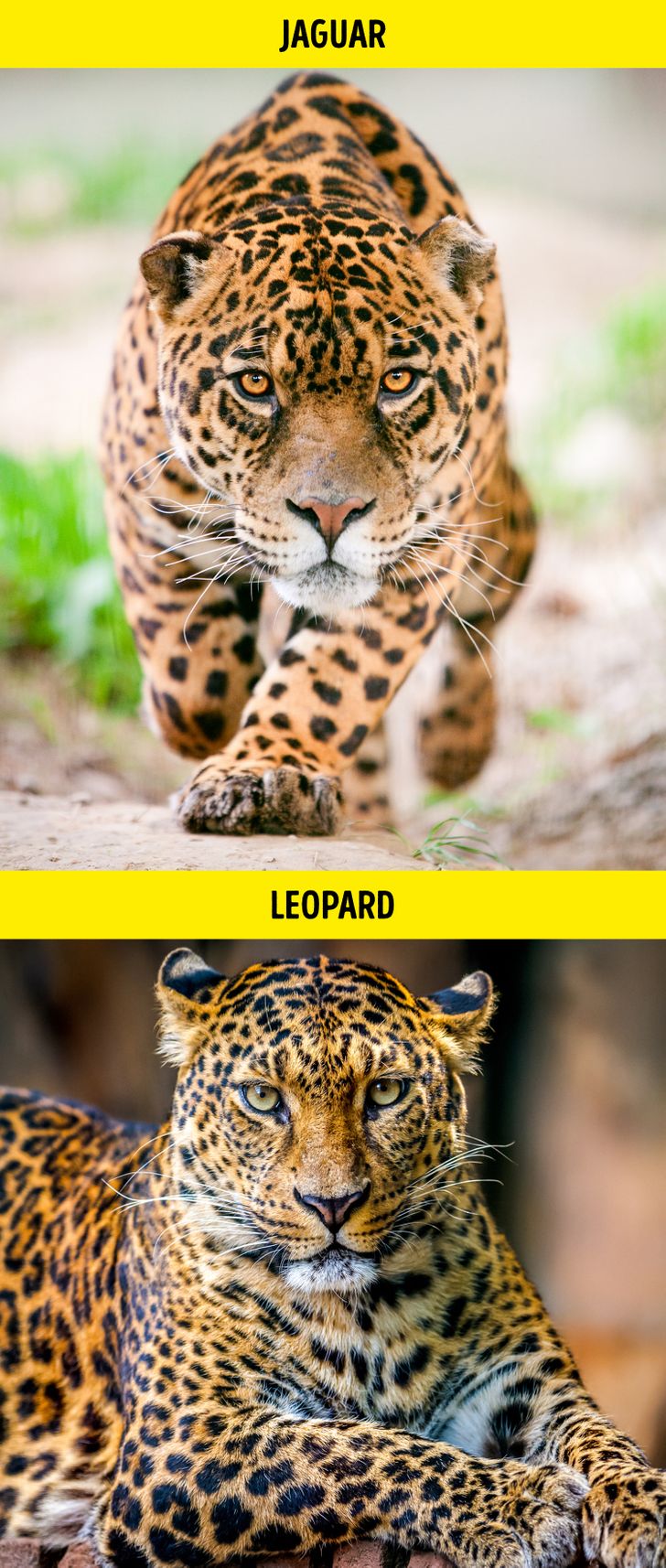
Despite their similarities, these big cats inhabit different continents and climate zones: leopards live in African savannas, while jaguars dwell in South American tropical forests. Jaguars are also larger and bulkier, and unlike leopards and many other cats, they’re fond of water.
2. Alligator vs crocodile
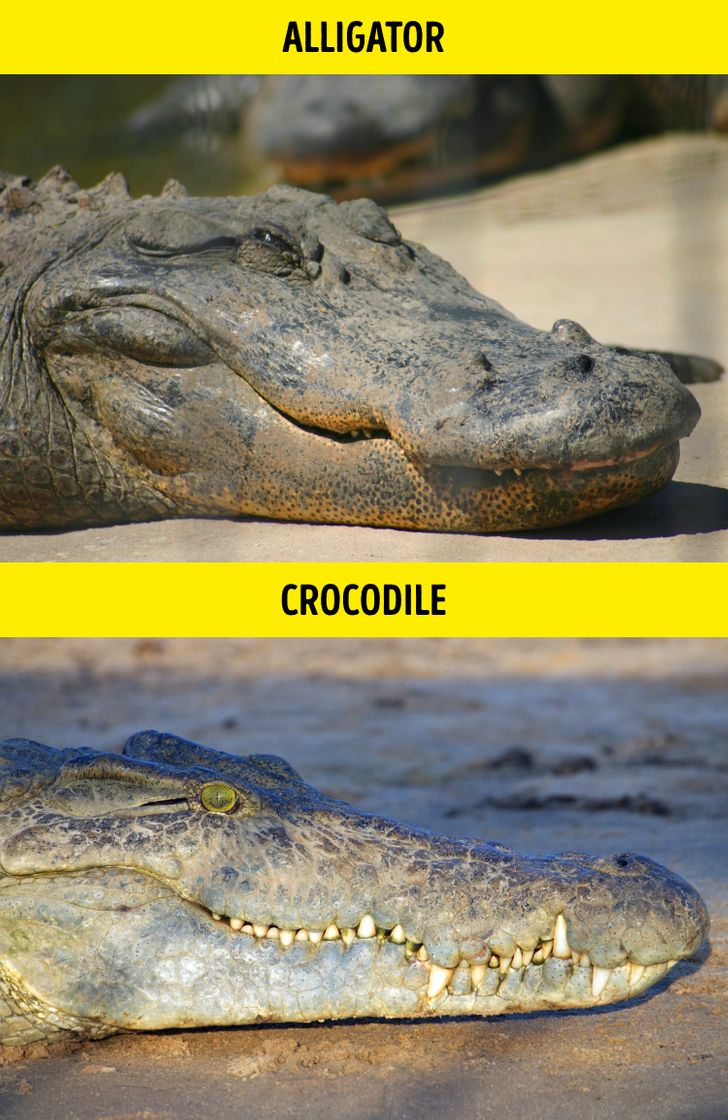
You can easily identify these 2 by the shape of their snouts: crocodiles have prominent, elongated V-shaped faces while alligators have shorter, wider U-shaped ones. Also, consider the teeth: crocodiles display their trademark toothy “grin” with every fourth tooth visible. Conversely, the alligator’s upper jaw is broader than the lower one, so its teeth aren’t visible for the most part.
3. Wasp vs hornet
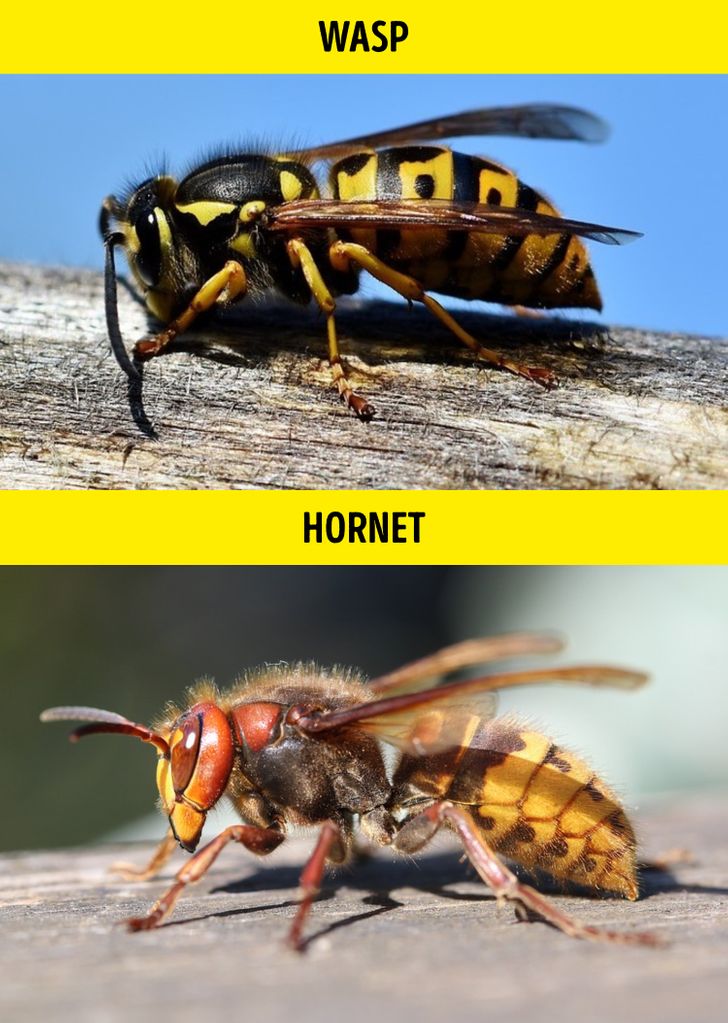
Both insects are menacing, that’s for sure. Hornets are larger and boast orange and black coloring, resembling spots rather than stripes, while wasps are more brightly colored and have yellow and black rings. You’re better off avoiding both.
4. Seal vs sea lion
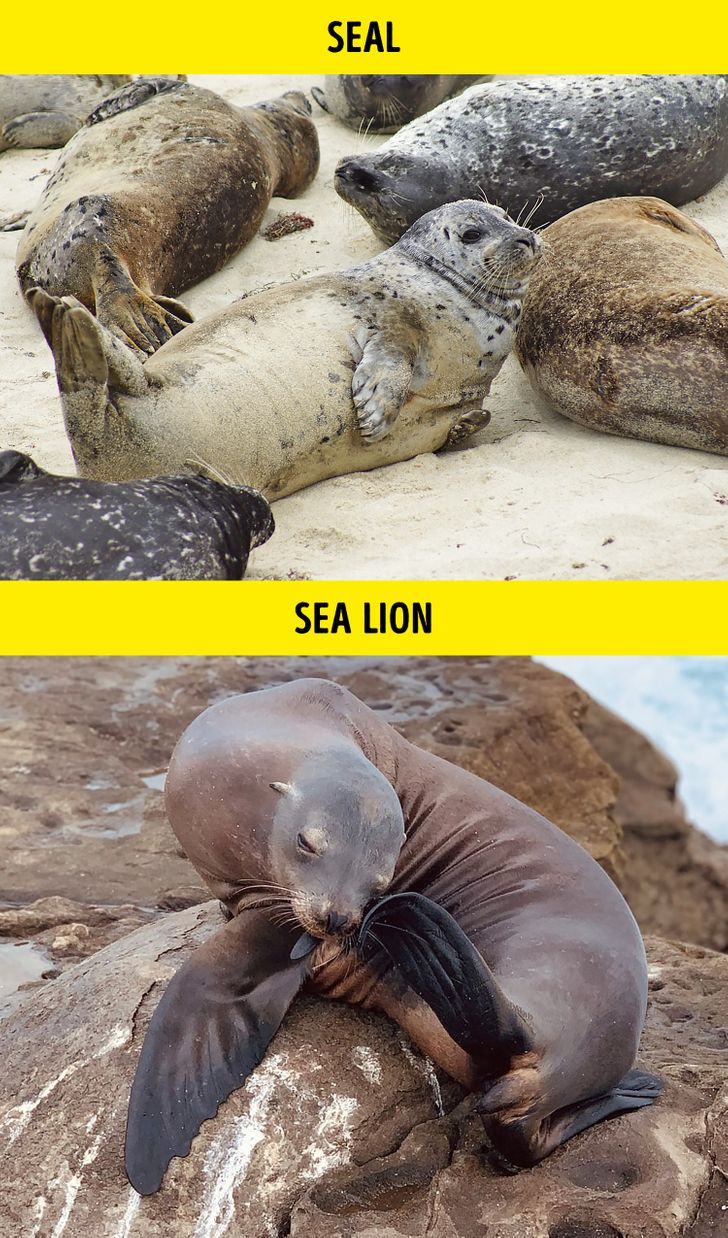
You’ve most likely met seals as cute plushy animals and sea lions as circus acrobats. Seals are covered with fur and have tiny front flippers which prevent them from walking, forcing them to wiggle on their bellies. Sea lions have smooth skin and vast flippers that they use to move on the ground.
5. Turtle vs tortoise
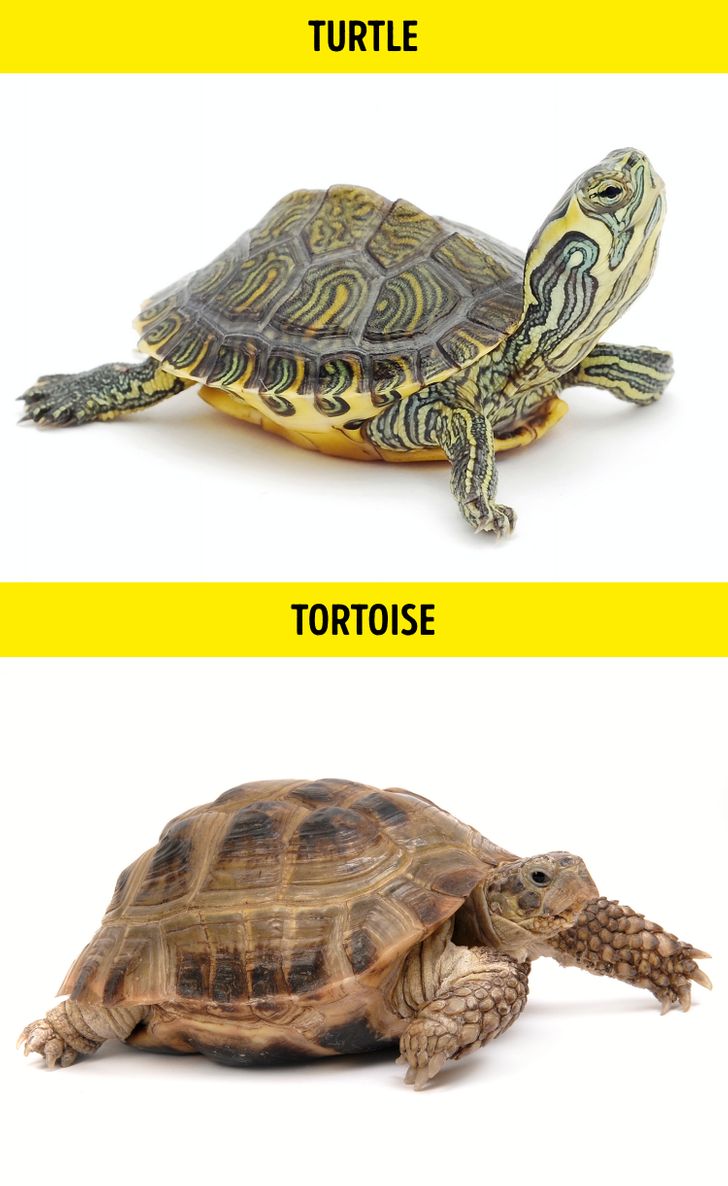
These 2 are both mobile (but very slow at that) and boast 4 legs. But the “turtle rock” is aquatic and has markings that resemble stains and circles on the water to better hide in the ponds. The “tortoise rock” is a land animal and spends most of its time on the ground — that is, as a literal rock.
6. Raven vs crow vs rook vs jackdaw

Most corvids look fairly similar (excluding jays who are like a theatre kid in a goth family). Ravens are the loftiest and most fashionable thanks to their “beard” of throat feathers. Crows and rooks are of the same size, but rooks have a distinct grey beak and fancy feather “pants” on their legs. Jackdaws are the goofiest-looking thanks to their very short beaks and a round heads with black caps.
7. Donkey vs mule
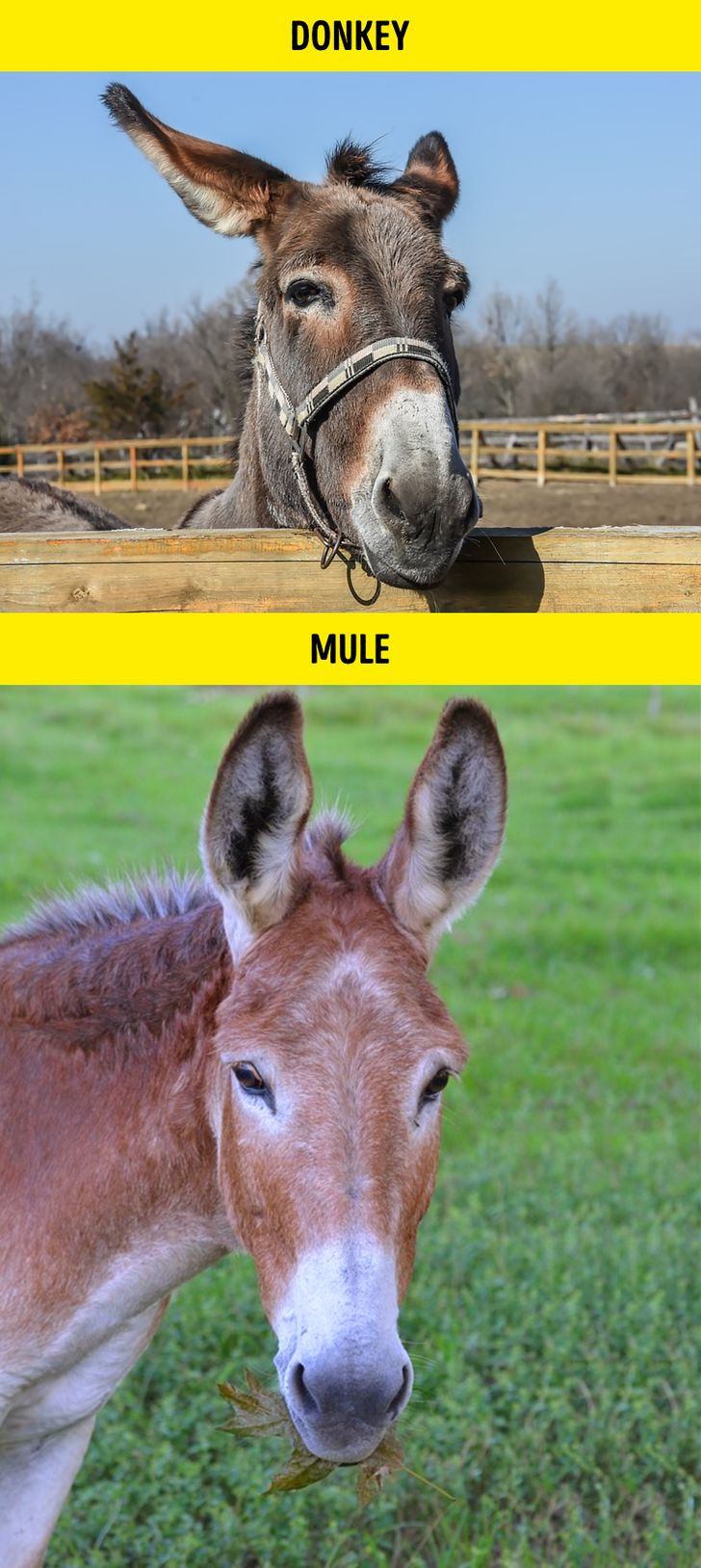
This one is tricky for a simple reason: while the donkey is its own species, a mule is a hybrid of donkey and horse. Funnily enough, it looks exactly like what you’d think these 2 animals would look like: an elegant head of a horse with ridiculously oversized donkey ears.
8. Hare vs rabbit
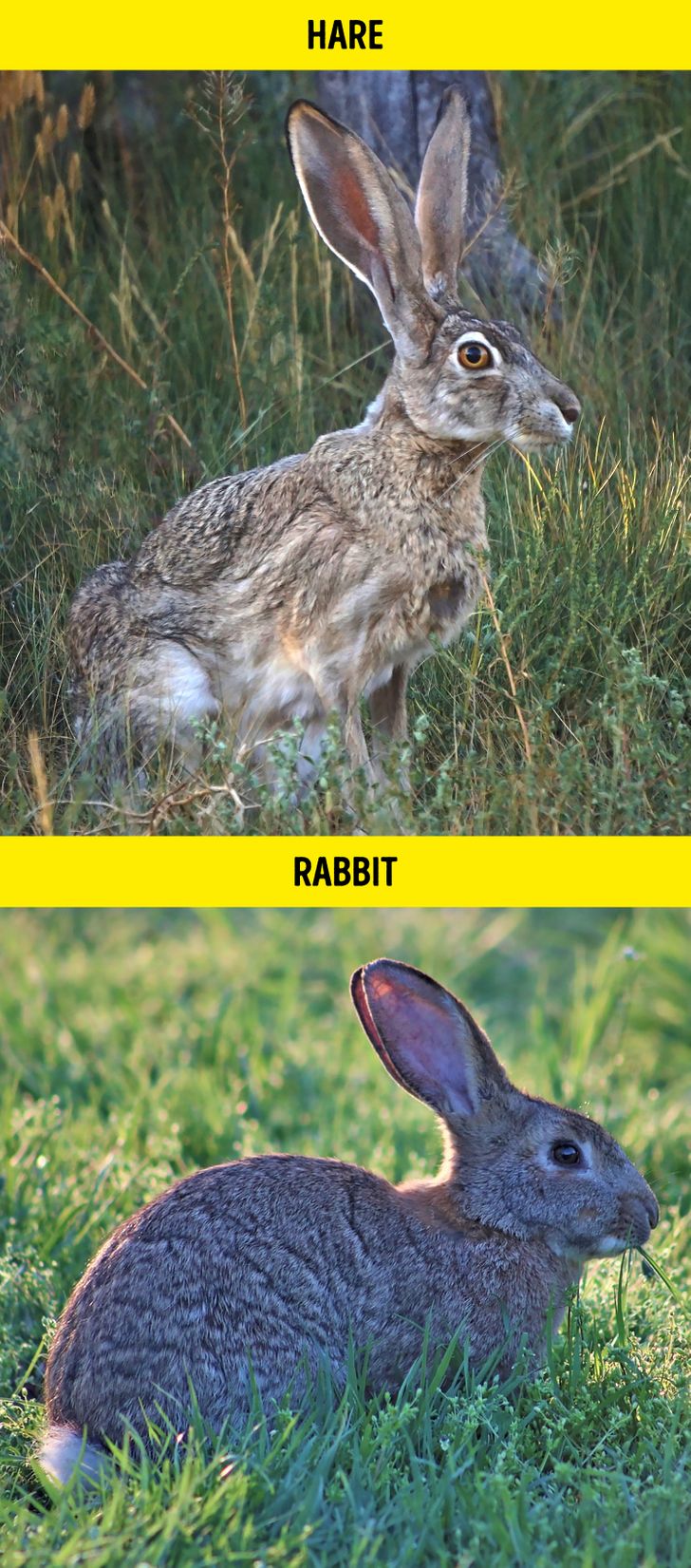
If you want a cuddly little pet, a rabbit is your best bet, but a hare definitely is not. Hares are larger and faster and have longer legs and ears. Rabbits are smaller, fluffier, and overall “cuter.” They even eat different food: rabbits prefer vegetables (like carrots) and soft grass while hares prefer bark and twigs. Rabbits are social animals while hares tend to be solitary. It’s no wonder rabbits are easily domesticated while hares mostly stay feral.
9. Moth vs butterfly
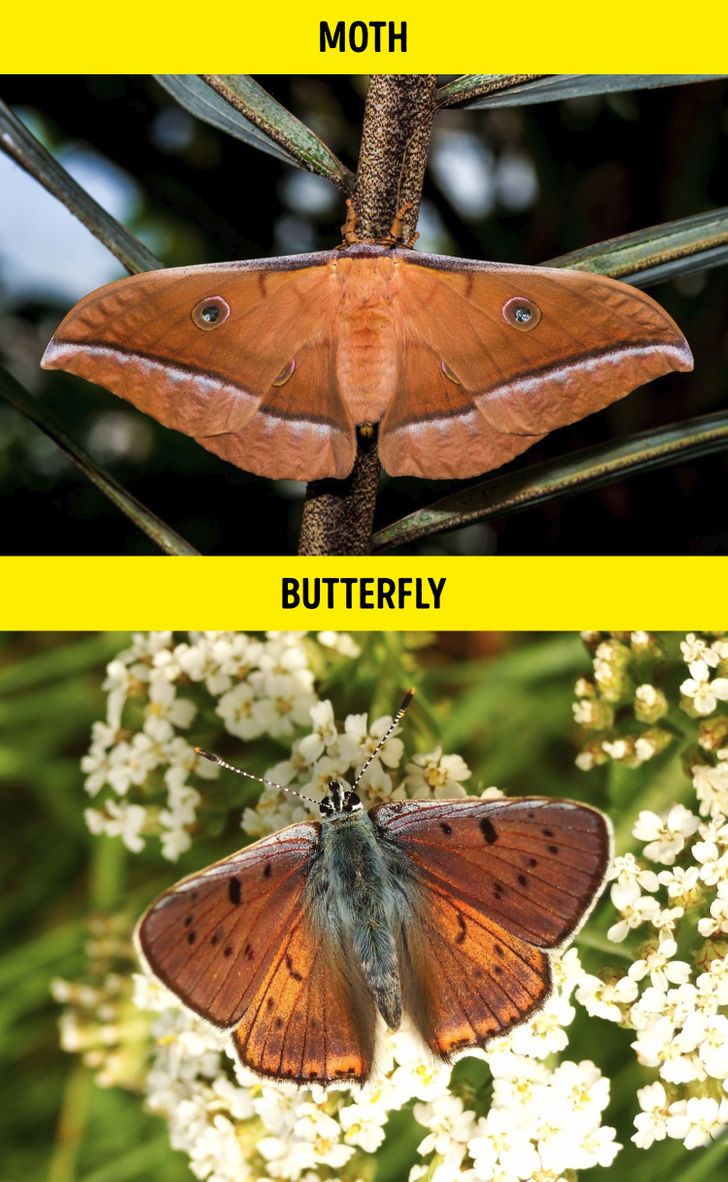
Moths have tent-like wings while butterflies flap their wings vertically. Moths usually rest with their wings open, while butterflies rest with their wings closed. Their antennas also differ: butterflies’ are long and thin and moths’ are short and feathery. Butterflies are strictly diurnal, while moths are mostly nocturnal.
10. Dolphin vs porpoise
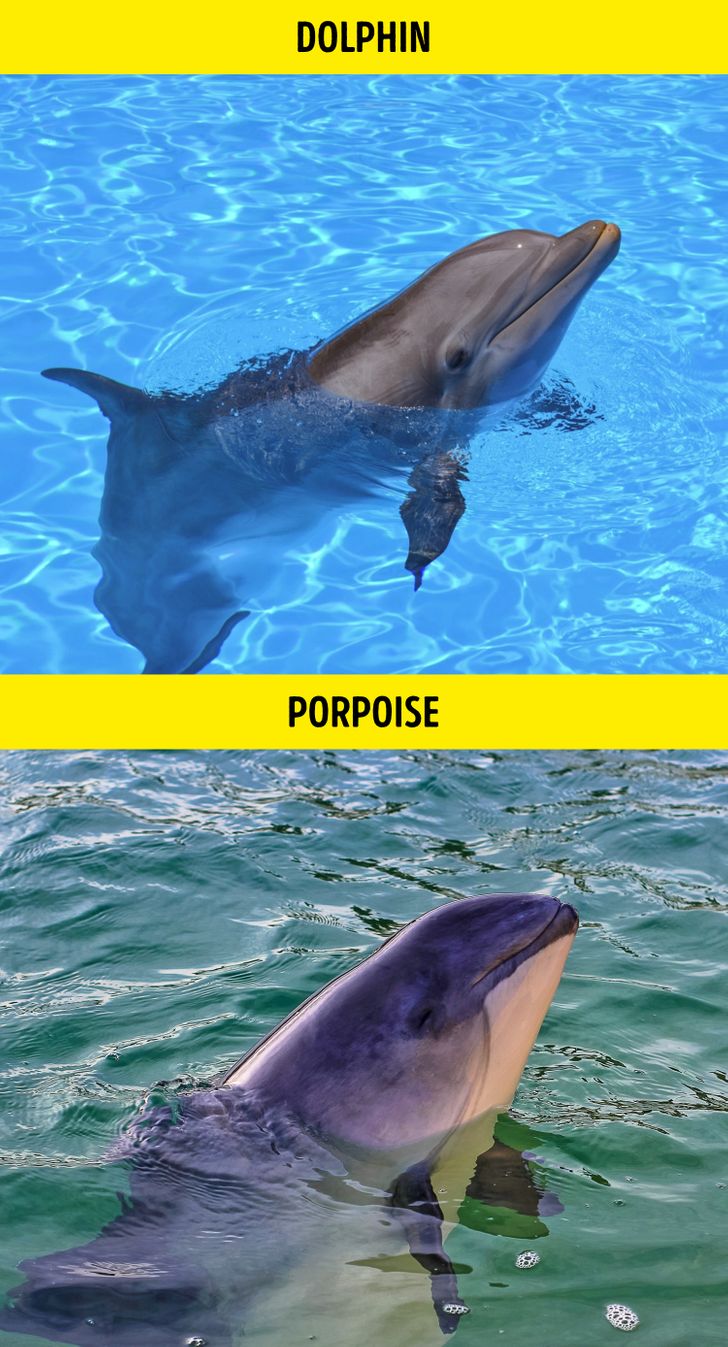
The difference between dolphins and porpoises comes down to their snouts, fins, and figures. Dolphins have long “beaks,” slender bodies, and curved dorsal fins. Porpoises have more flat, sloping faces, smaller flippers, and shorter triangular dorsal fins.
11. Weasel vs stoat
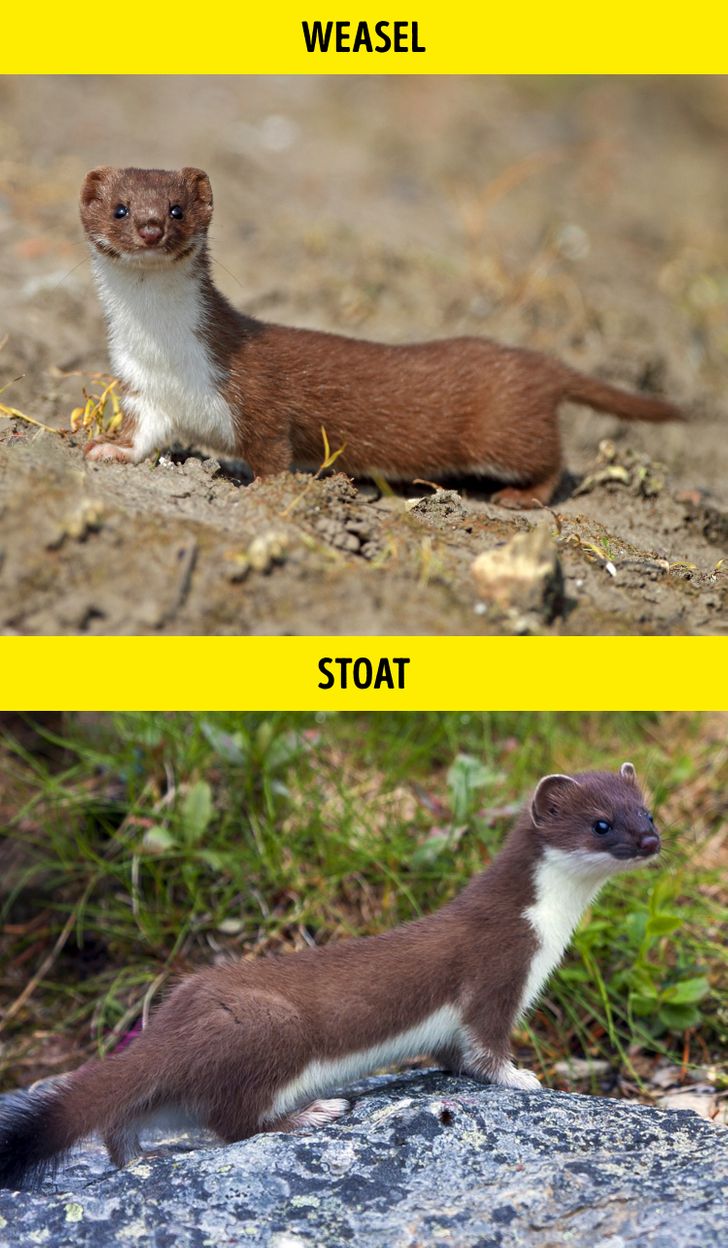
These 2 animals are close relatives. Stoats are bigger and have long tails with fuzzy black tips, while weasels’ tails are short and of the same color as the rest of the body. Stoats move in a bouncing gait with an arched back which looks hilarious, and weasels keep closer to the ground. Stoats also turn white in winter.
12. Eagle vs hawk vs falcon
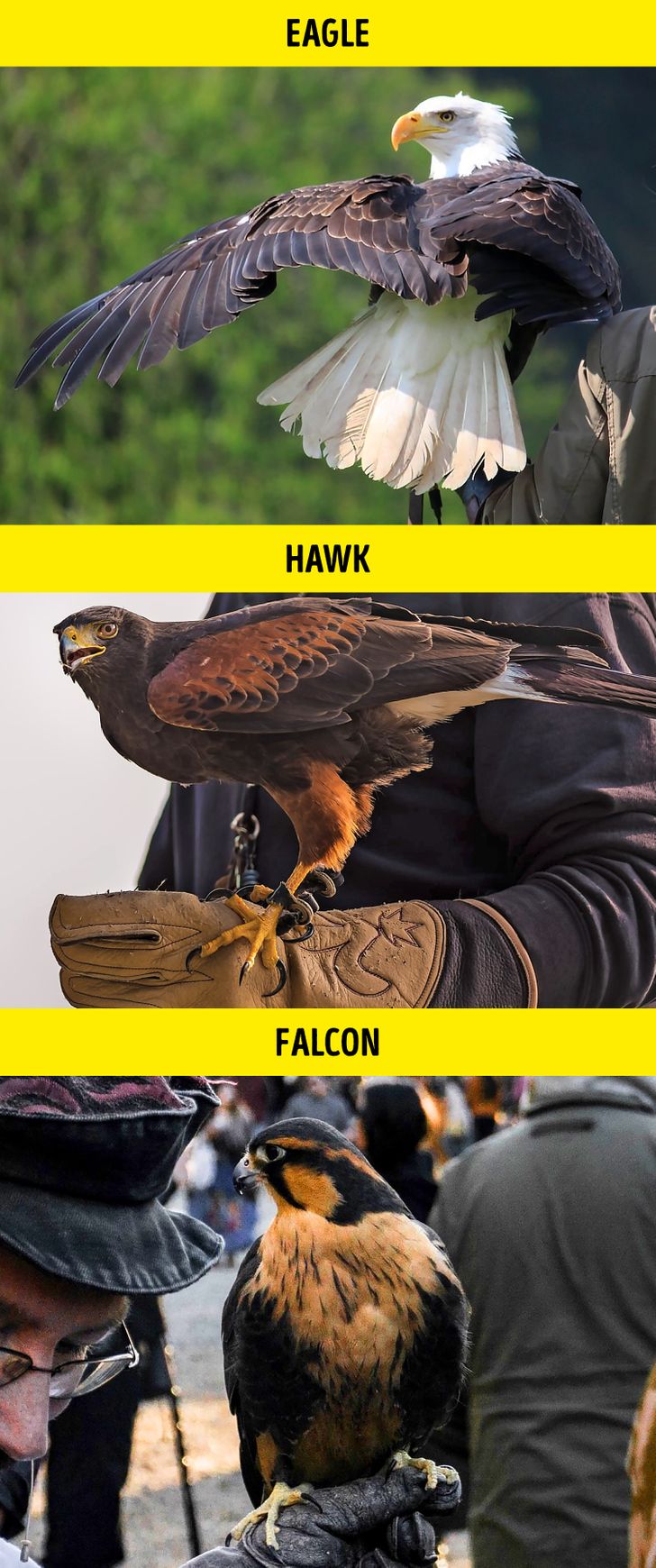
Eagles are gigantic, powerful birds who prefer to live in open spaces like cliffs and mountains. Hawks are a little smaller and more nimble in the air, capable of maneuvering in more closed areas. Falcons are the smallest and fastest of the 3 and differentiate the most visually: they have larger eyes and shorter beaks.
13. Mouse vs rat
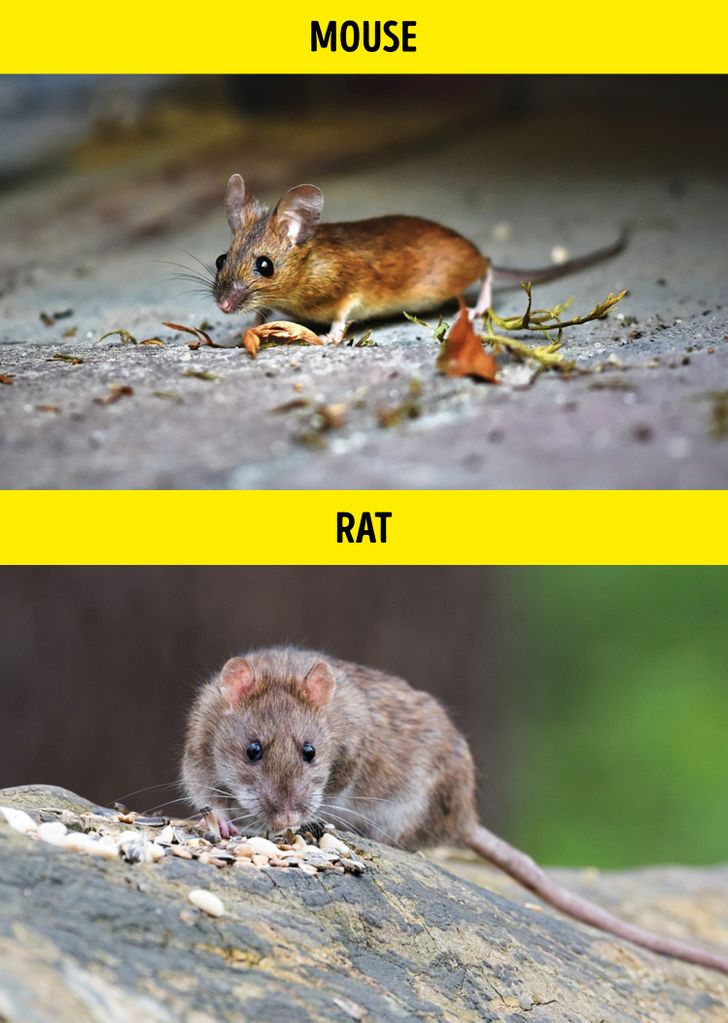
The 2 most famous (or infamous) rodents can be easily distinguished by 3 things: their size, tail, and ears. Mice are diminutive, even compared to young rats; they have thin long tails covered with fur while rats’ tails are thick and hairless. Mice have ears that are bigger in proportion to their bodies and are round and floppy with a tiny, triangular face. Rats’ faces are more prominent and blunt.
14. Seagull vs albatross
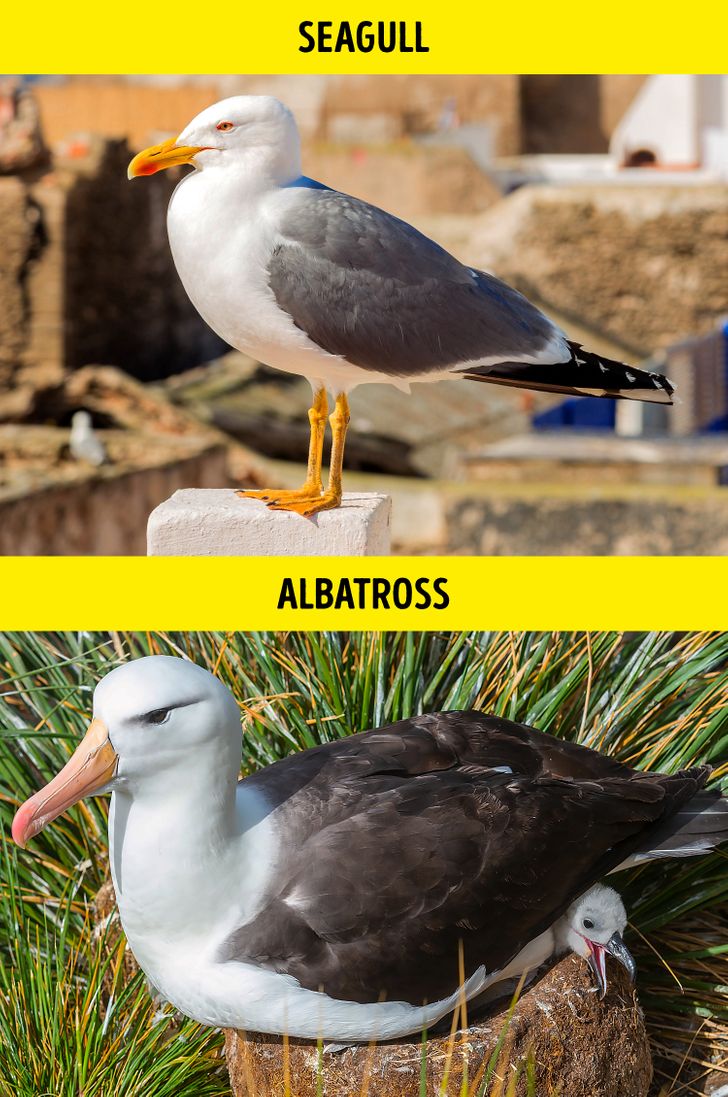
Gulls often live near water, be it the sea or ponds, and are rather acrobatic while diving and fish-catching, but aren’t fans of long voyages, unlike albatrosses. Albatrosses are portly birds who live in constant flight over the sea. They even have unique nostrils that allow them to remove salt from water and food.
15. Wolverine vs honey badger
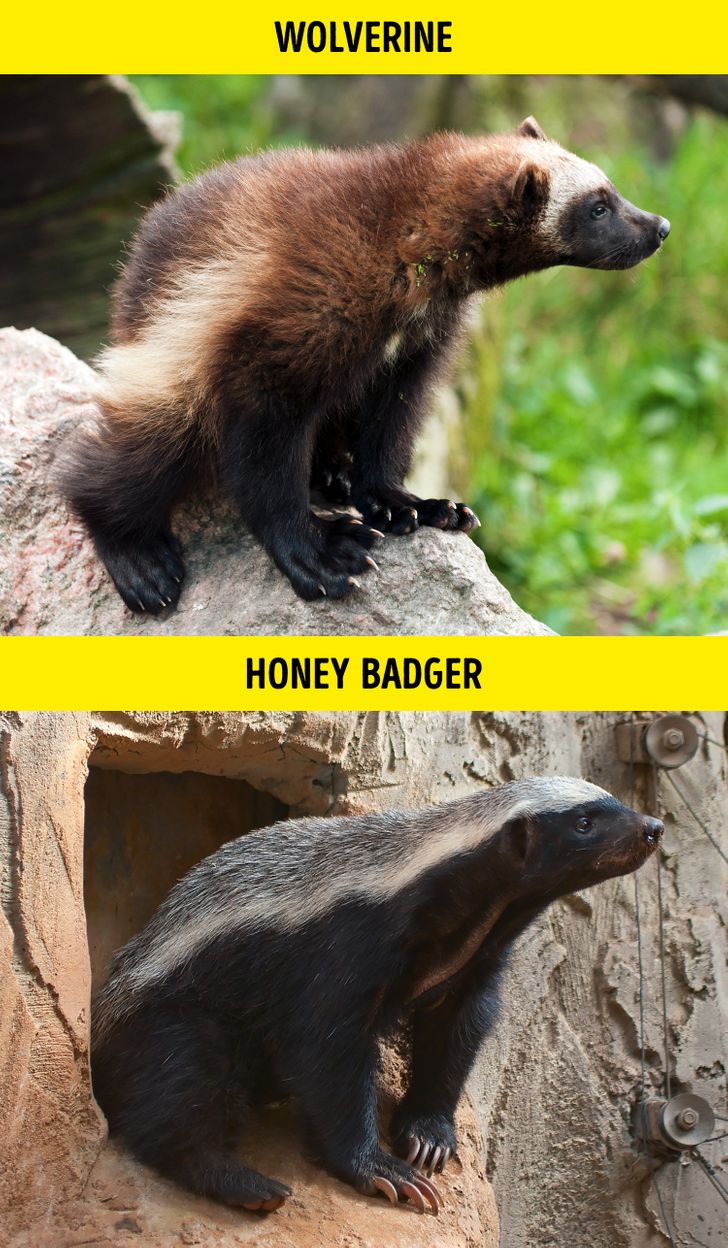
Despite living in different climate zones — the honey badger that lives in Africa and the wolverine that resides in the northern forests — both belong to the Mustelidae family. Wolverines are taller with longer legs and noticeable ears and have brown fur with yellow rings. Honey badgers keep closer to the ground and have black bodies with a white “cape” on their backs.
16. Wolf vs coyote vs jackal
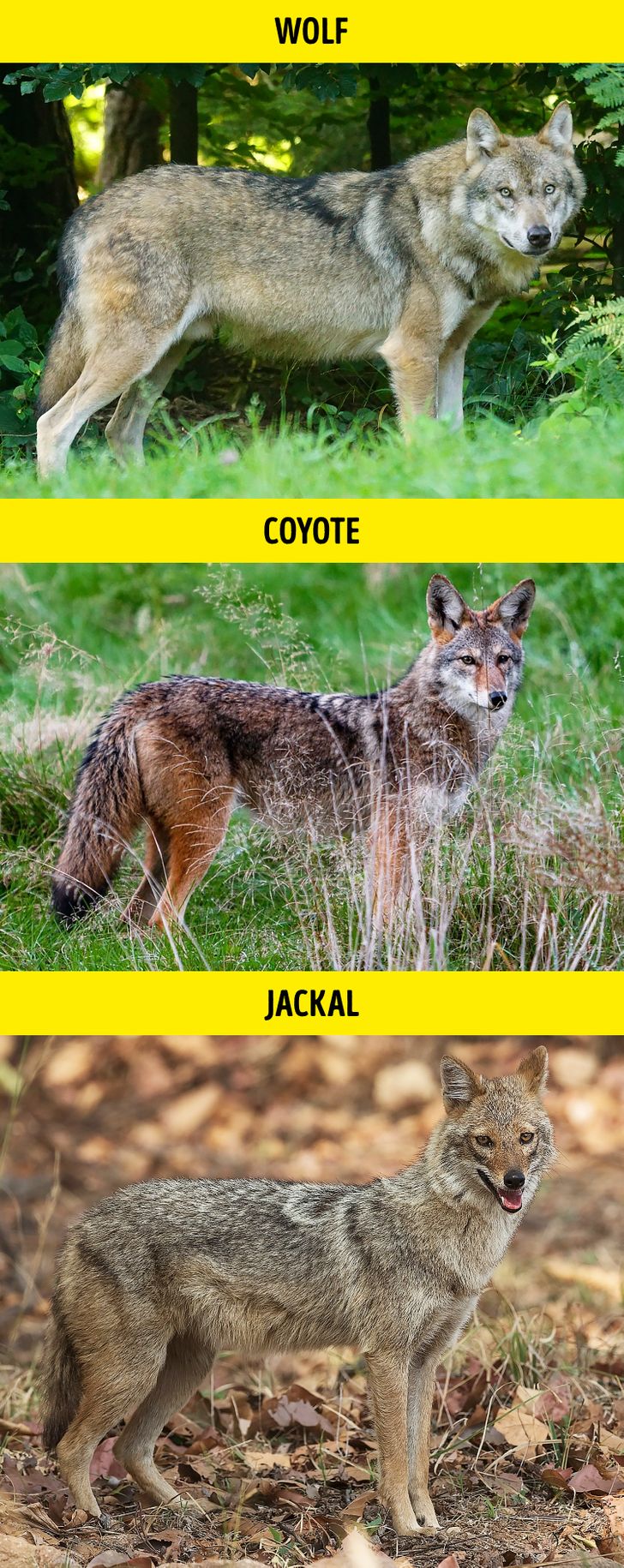
These 3 are “good boys and girls” that parade all over the globe. Jackals live in Africa, Asia, and India; coyotes live in Northern America; and wolves live all over the place. Wolves are large, sturdy animals, while coyotes and jackals possess a more lean and fragile frame.
Coyotes are recognizable for the red fur on their faces and ears while jackals have a more yellow-colored coat. Additionally, jackals are noticeably less fluffy because they don’t have to endure the harshness of winter.
Funny bonus: Wolverine vs the honey badger
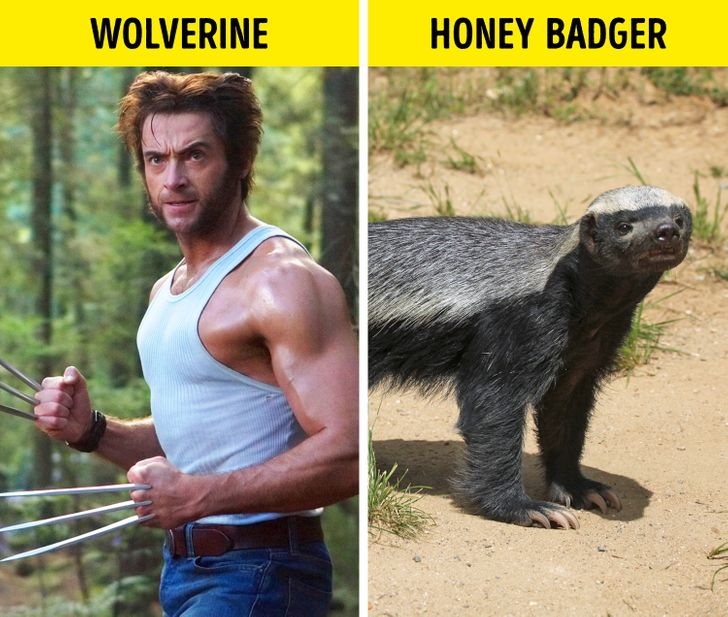
What kinds of animals have ever confused you? If you know more examples, share them in the comments!
Preview photo credit shutterstock.com, shutterstock.com
Serving as a Waitress at a Wedding, I Was Stunned to See My Husband in the Groom’s Attire

While serving at a wedding, I suddenly spotted the groom—it was my husband, David. Seeing him with another woman, pretending to be someone else, sent my world crashing down. In that moment, everything I thought I knew about my life was turned upside down.
Oh, weddings… They always had a way of stirring up old memories, bringing me back to that day when David and I said our vows. Our wedding wasn’t anything grand or over the top—far from it, actually.
We were just two young people in love, not concerned about fancy decorations or a big reception. Even now, after seven years of marriage, those memories still brought a smile to my face.
Working as a waitress for a catering company meant that I was always around weddings. Every time I walked into a beautifully decorated hall, the smell of fresh flowers in the air, I couldn’t help but think back to our simple ceremony. If only I had known how fragile things could be…
That day, just like any other, we arrived early to set everything up before the guests and the newlyweds showed up.
About an hour later, the guests started arriving, their excited chatter filling the hall as they waited for the bride and groom to return from their photo session. I was in the restroom when Stacy, my colleague, burst in, her face pale with worry.
“Lori, listen,” Stacy said, her voice shaky, “I think you should go home.”
“Go home? Why would I do that?” I asked. “Are you trying to get more shifts for yourself? Sorry, but I need the money just as much as you do.”
Stacy shook her head, looking more nervous than I’d ever seen her. “No, Lori, you don’t understand. I really think you shouldn’t be here.”
“What are you talking about? Why are you acting so weird?” I said. “Stacy, seriously, what’s going on?”
She bit her lip, glancing toward the hall. “You’re not going to like what you see.”
I headed back to the hall, my mind racing with thoughts of what Stacy had said. My heart nearly stopped when I saw the bride and groom. Stacy was right—I shouldn’t have come.
There, standing in front of all the guests, was David… my David. The man I had shared my life with for seven years, now standing with another woman.
My breath caught in my throat. I felt like the ground had been ripped out from under me. I couldn’t make sense of what I was seeing. I turned and ran outside, tears streaming down my face. It was like a nightmare, one I couldn’t wake up from.
Outside, I collapsed against the wall, gasping for air. My vision blurred with tears, but I forced myself to look at the sign with the bride and groom’s names: “Welcome to the wedding of Kira and Richard.” Richard? What a liar!
Stacy rushed outside. She tried to speak, to comfort me, but I couldn’t hear her. All I could think about was how he had betrayed me. I wiped my tears away, anger building inside me. I wasn’t going to let him get away with this. No way. I was going to ruin this wedding and expose him for the fraud he was.
I returned to the hall just as the bride and groom were giving their first toast. My heart pounded in my chest, but I knew I had to do this.
I marched straight up to David and snatched the microphone right out of his hand. He looked at me, his face full of shock and anger, but I didn’t care. He deserved every bit of what was coming.
“I have an announcement!” I shouted into the microphone, my voice echoing through the hall. Every head turned toward me, the room falling into a stunned silence.
The bride, this poor woman, clung to David like he was her lifeline. She looked at me with wide, fearful eyes, clearly not understanding what was happening.
“David, or as you all know him, Richard, has deceived you all!” I began, my voice trembling with rage. “He’s already married! To me!” The words hung in the air like a bomb that had just gone off. Gasps rippled through the crowd, and I could see the confusion and disbelief on their faces.
“What?” the bride stammered, her voice barely above a whisper. She turned to David, her eyes filling with tears. “Richard, what’s going on? Who is this woman?”
David shook his head, his face a mask of feigned confusion. “I… I don’t know,” he stammered. “I’ve never seen this woman in my life.”
“Seven years of marriage, and you were blind?!” I shouted, feeling my anger boil over.
“What? What seven years of marriage?” he asked, still trying to play dumb.
“Stop pretending you don’t know me,” I said. “You’re only making it worse, David.”
“My name is Richard!” he shouted back, his voice desperate. “I have no idea who your David is. You’re crazy!”
“Oh, really?” I said, narrowing my eyes. “Then what’s this?” I pulled out my phone, the screen lit up with a picture of our wedding day. I held it up for everyone to see. The room fell into a deeper silence as people strained to get a look.
The bride, Kira, stepped closer, her eyes locking onto the image. “Richard…?” she asked, her voice trembling. “How could you do this to me? How could you lie to me like this? And to her?” She pointed at me, her hand shaking as tears spilled down her cheeks.
“Kira,” Richard said, his voice softening as he reached for her. “I swear, I don’t know who this woman is or why she has a photo with me. I would never hurt you.”
But the bride shook her head, backing away from him. “I loved you, Richard… or David, or whoever you really are,” she said, her voice breaking. “How could you betray me like this? I don’t even know who you are anymore.”
“I’m Richard,” he insisted, desperation creeping into his voice. “And I love you, Kira. I’m telling the truth!”
I couldn’t hold back a bitter laugh. “He’s probably only with you for your money,” I said, the words dripping with contempt.
“Shut up!” David yelled, his voice raw with anger and fear.
The bride shook her head, tears streaming down her face. “No, Richard, I can’t do this. I can’t be with someone who could lie like this, who could do something so awful.”
She turned to me. “I’m sorry,” she whispered. “I really didn’t know.”
“It’s not your fault,” I replied, my voice softening. “He deceived us both.”
“Kira, please,” David begged, but it was too late. She was already turning, running toward the door, her wedding dress trailing behind her like a broken dream.
Without a second thought, David bolted after her. “Kira! Wait!” he shouted as he disappeared through the doors after her, leaving the stunned guests and me standing there in silence.
I stormed outside, ready to tell David I was done and filing for divorce. But when I found him, he was sitting on the curb, tears streaming down his face.
“Of course, play the drama,” I said, crossing my arms.
He looked up, his face twisted with anger. “You! This is all your fault!” he shouted. “My wife ran away from me, and it’s because of you! Some crazy waitress!”
“I’m the crazy one?!” I yelled back. “You’re the one who married another woman while still being married to me!”
“I’m not your husband! I’ve never seen you before in my life!”
“Oh, really?” I challenged, pulling out my phone. “Then let’s call David, who you claim you’re not, and see what happens.”
“Go ahead, call him!” he snapped.
I dialed David’s number, putting it on speaker, but the phone just kept ringing. “How strange that you’re not picking up,” I said, my voice dripping with sarcasm.
Then, suddenly, the ringing stopped, and I heard his voice. “Yes, dear. Is everything okay?”
“What the…?” I stammered, staring at the man in front of me.
“I told you I’m not your husband!” he said, his voice calmer now, but still tense.
“Honey,” I said into the phone, trying to keep my voice steady, “I think you should come here; something strange is going on.”
David arrived about half an hour later. For what felt like forever, he and Richard just stood there, staring at each other in complete silence. It was like looking into a mirror—they were identical in every way.
Finally, Richard broke the silence, turning to me with a wry smile. “Well, if I were in your shoes, I would’ve done the same,” he said.
David’s eyes shifted to me, filled with hurt and confusion. “How could you think I would do something like this to you?” he asked quietly.
“He’s your exact double,” I blurted out, desperate to make him understand.
“Yes,” David replied, his voice soft. “But it still hurts that you thought that.”
“I’m sorry, honey. I was just so angry and hurt,” I said, reaching for his hand.
As it turned out, Richard and David were both adopted from the same orphanage when they were just babies. But they were taken in by different families. They had no idea the other existed. I couldn’t believe what I was hearing. My husband had a twin brother he never knew about.
“But that doesn’t change the fact that my wife hates me,” Richard said, his voice filled with despair.
“We’ll fix that,” I replied.
“Yes, get in my car, and let’s go,” David added, already moving toward the car.
“She’ll never forgive me,” Richard muttered.
“She will when she sees David,” I assured him.
We drove in silence to the hotel where Kira was likely staying. We went to her room, but she wouldn’t let us in. I could hear her crying through the door, and it broke my heart.
We didn’t give up. We stood outside under her window, shouting up at her, trying to get her attention. Finally, she looked out the window, her eyes red from crying.
“Kira!” I shouted, waving my arms to get her attention. “Your fiancé didn’t lie to you! And my husband didn’t cheat on me! Look!” I pointed to Richard and David, who stood side by side, identical in every way.
Kira’s eyes widened in shock. “How is this possible?!” she shouted down at us.
“We were separated in the orphanage!” Richard shouted back.
For a moment, she just stared at us, then she closed the window, and our hearts sank.
“See? I told you she wouldn’t forgive me,” Richard said, his voice heavy with defeat. But just as the words left his mouth, the door burst open, and Kira ran out, tears streaming down her face. She threw her arms around Richard and kissed him, holding him tight.
David pulled me into a hug. “I’m sorry I doubted you,” I said softly, looking up at him.
David smiled, brushing a strand of hair from my face. “Oh, I think I would’ve done the same. Honestly, I’m flattered that after seven years of marriage, you’re still willing to fight for me.”
I laughed, nudging him playfully before leaning in to kiss him. So, my husband gained a brother, and I gained a friend I can’t imagine my life without.
Tell us what you think about this story and share it with your friends. It might inspire them and brighten their day.



Leave a Reply